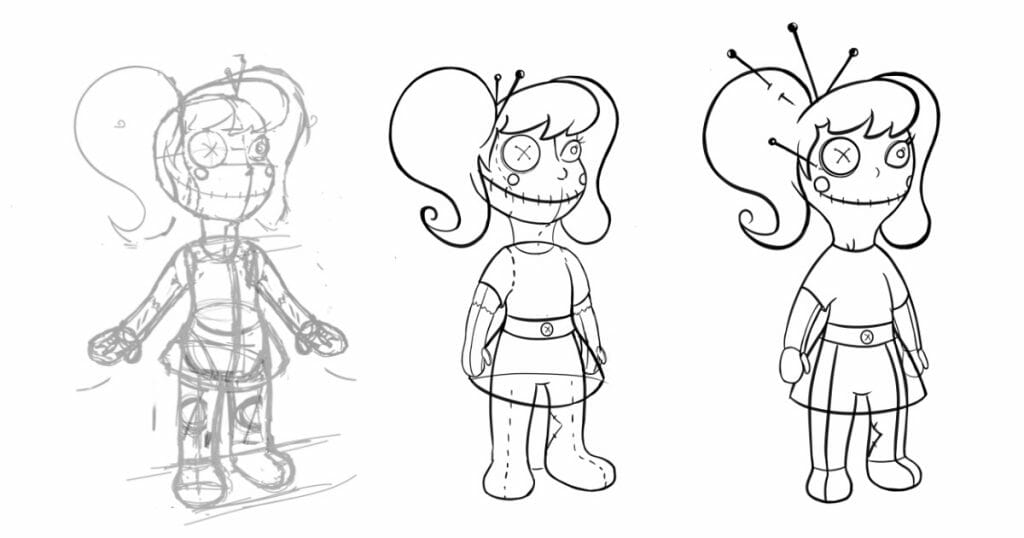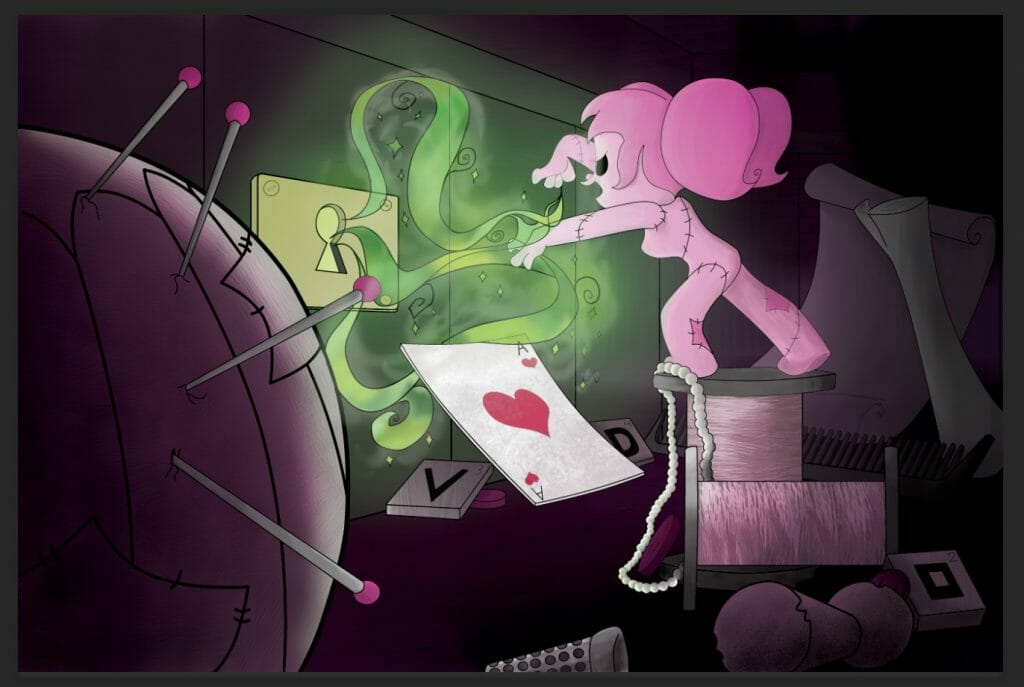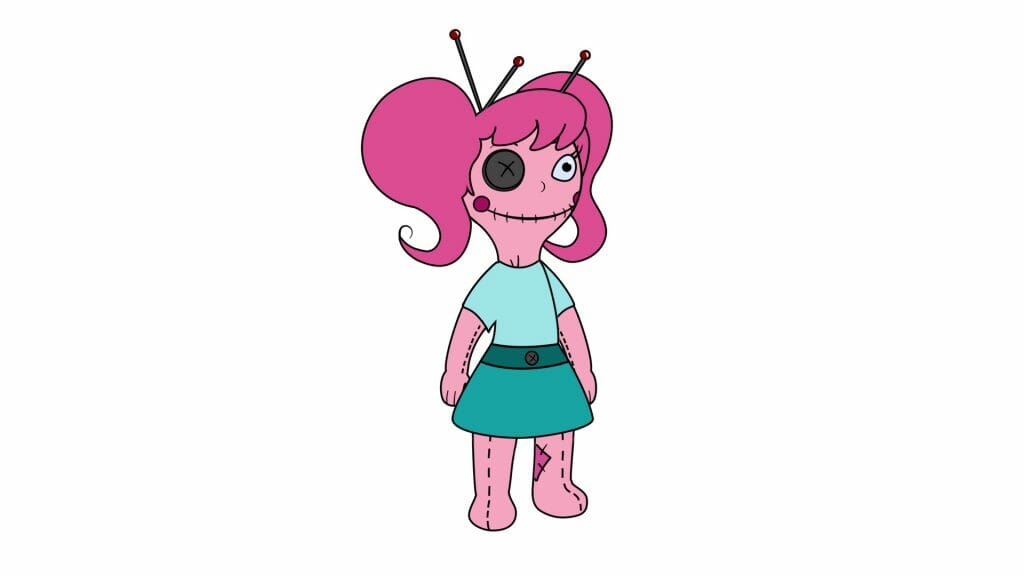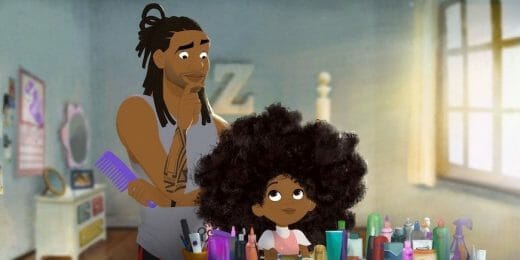
Ramona Iacono is a freelance builds and rigging artist who has already worked with several prominent studios — including Mercury Filmworks, Titmouse and Jam Filled — since graduating from Algonquin College’s animation program in 2021. While at Algonquin College, Ramona created her first character rig. An ode to Ramona’s fondness for the creepy-but-cute aesthetic, Cali is a character she developed throughout the program.
We caught up with Ramona to learn about her experience in Algonquin College’s animation program, her career in the animation industry since graduating, and the work that went into her Cali rig.
Hi Ramona! To start, can you tell us about how your animation career got started, and a bit about your career so far?
Ramona: My animation career started back in 2015 when I joined the pre-animation program at Algonquin College. The year following that I went into the full three-year animation program. In my second year, a strike happened that lasted several weeks. School became even more overwhelming. Despite being on strike, it felt like our workload didn’t change. I became so stressed out, I decided to quit.
After a few years away from animation, I decided to go back to it. At that same moment, the pandemic started. The pandemic was horrible of course. But being in lockdown, I was able to focus intensely on school. I was also older and more mature, and so the schooling landed better with me. Ultimately I’m glad I took that break in the middle of the program because I came back to it in the right mindset.
In the second semester of my final year in the program, I applied for a co-op position at Mercury Filmworks. After finishing my co-op and my animation program in mid 2021, I worked at Mercury full-time for several months before switching to freelance. I worked with Yeti Farm and with Titmouse during that period. It was incredibly busy, but I learned so much from those freelance contracts. More recently I’ve been working with Copernicus Studios and with Jam Filled Animation.
What was your experience in Algonquin’s animation program like? What was your favourite part of the program?
Ramona: The program was really hard at first because, in the first and second year, you do traditional animation on paper. I had learned how to draw in pre-animation, but I felt like my skills weren’t quite there yet. I spent tons of time practicing, and after taking my break from the program, I came back with a way stronger grasp on drawing. I ended up loving paper animation the most. It gave me a really strong foundation for working with Harmony.
After that initial struggle, I really thrived. The third year of the program was really exciting because you get to pick whatever you want to focus on. I did a little bit of special effects, my own builds and character animation.

You’ve just started working with Jam Filled. Do you have advice for artists who are starting a new role at a studio?
Ramona: Every studio approaches things a little bit differently, and so the most important thing is to ask lots of questions. I know it can be scary, especially when you’re the new person, to ask questions, but it’s such an important part of the learning process.
I know from personal experience that it’s really easy to give in to the imposter syndrome that basically all of us experience in our careers. Especially when you’ve just graduated from school, it’s easy to question whether or not you belong in the industry. It’s important to remember that grades don’t matter any more – you’re hired! Your employer already knows you can do the job. It’s totally okay to ask questions that will help you do the best work possible.
Tell us about Cali! Can you describe the character and what inspired the design?
Ramona: I started drawing Cali in the first semester of pre-animation. For the final of that semester, we got to create our own characters with a full turn-around. We drew them in different action poses and expressions. This was a great exercise for diving into your own creativity.
At the time I was really obsessed with A Nightmare Before Christmas. I love Tim Burton’s style. I love the creepy-but-cute look of the movie’s characters, like Jack Skellington. Cali was definitely inspired by this kind of aesthetic.
After pre-animation, I didn’t work on Cali for a few years. I brought her back to life for my final project in the final year of my animation program. That was a rewarding experience because I got to put her through some design changes, making her look a little more voodoo-esque over time. I also dreamed up a backstory for her.
Cali’s villain origin backstory is that she was made in a factory; She was meant to have eyes, but was faulty, and so she got tossed into the trash. She came back to life in the garbage and escaped, deciding that she would one day burn down the factory. She meets another character, a teddy bear that was also thrown out. He helps her burn it down.
Later, both Cali and the bear get picked up by a used toy shop. A little girl comes into the shop and gravitates toward Cali because she’s also blind. So Cali in the end finds a home with this little girl and finds her own people!

Take us on a tour of the Cali rig! What was your favourite part of creating it?
Ramona: I really enjoyed building this rig from start to finish. When you’re in school, you’re provided rigs to play around with, but it’s hard to get a grasp on how they’re built and how they work. Being able to dive into building one completely on my own was so helpful for learning.
My favorite part of Cali is the master controller that I created that toggles between her different facial expressions. When I went to create a master controller I clicked the slider tool, and selected the frames that I wanted in the range. The slider makes it really simple to transition between her expressions. It’s funny, my teacher told me not to bother with it, I didn’t have to create a master controller for that. But I wanted to do it because it made Cali come more alive.
Is Cali similar to other production rigs built at most studios?
Ramona: I would say building Cali’s rig was pretty similar to how rigs are built at most studios. I created Cali while I was in school under the guidance of teachers who worked themselves with studios, and so they taught us the process that is standard in the industry. The one thing I did with Cali that studios tend to stay away from is auto-patching. Some studios avoid the auto-patch node because of the haloing issues that can happen.
What features of Harmony do you find most useful in character design and rigging?
Ramona: The whole program is really intuitive. There’s so many different ways to do things, which I find really cool because that means there’s endless opportunities to discover new tools and new strategies. I’ve found that at every studio I’ve worked at, I’ve learned something new about how to use Toon Boom Harmony. My favourite thing right now is kinematic output because it reduces how many deformers I need to use. And I also love cutters. Being able to lay things within a shape is so fun!

Is there anything you’ve learned from the process of designing Cali that has changed or informed how you approach character design?
Ramona: Absolutely. A big takeaway for me in building Cali was how important it is to avoid overcomplicating a rig. You need to strike a balance between making sure a rig has all the functionality it needs, without going overboard.
I also learned that as a builder you sometimes have to make parts up. Sometimes little details of a design that you receive will be missing. For example, if you get a design where a character is wearing a backpack, but only in one of the poses, you’ll have to decide how that backpack appears in the whole turnaround. This is where attention to detail, and the ability to approach things simplistically is so important.
What’s next for Cali, and are there any other projects you’d like to share?
Ramona: It’s funny, Cali’s rig is now two years old. I’ve learned so much since building her, and so now when I look at her rig, I really want to go back in and make updates. I would love to fully rebuild her, and build out a full turnaround. I would also love to animate with her.
It’s tough when animating is your full-time job, because when work for the day is done, you don’t always have the energy to then work on your side projects. For now I’m focusing on my career, but down the road I really do hope to get back to working on Cali. I miss her!
At work I’m currently on some great projects, but unfortunately I can’t talk publicly about them yet. However a couple projects I was on have wrapped up and been released: The Ghost and Molly McGee from Mercury Filmworks is now out, and so is Summer Memories from Yeti Farm. Most recently, Agent Elvis, which I worked on with Titmouse, was released on Netflix.
- Interested in seeing more of Ramona Iacono’s work? Be sure to visit her portfolio website and follow her on LinkedIn.
- Ready to begin rigging your own project? Artists can download a 21-day trial of Harmony Premium.



